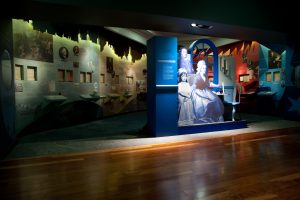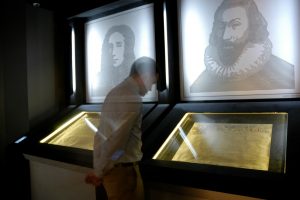by Rivi Feinsilber
Dr. Stephen Kenney is the Museum Director of the Commonwealth Museum right here in the state of Massachusetts. He earned his PhD in International Relations from Boston University and started his career as a faculty member, administrator, and grant writer in higher education, most notably as Interim President at Quincy College. From there, he joined the Commonwealth Museum and became the director a year later, staying in the position for the last twenty years. His tenure at the museum involves advocacy through administrative tasks such as supervising staff and raising money, but his major duty is outreach through planning and executing events and exhibits that showcase the collections that teach the public the history of Massachusetts in and outside the museum.

The Commonwealth Museum, free and open to the public, tells the story of the state of Massachusetts. Dr. Kenney stated the museum fulfills this mission by conducting educational and cultural programming using the material held in the Secretary of Massachusetts, mainly to school groups. These groups are a daily occurrence, offering a free bus to low-income schools that removes financial barriers that prevent learning and important foot-traffic for the museum. The children experience the most breathtaking if not also the most important exhibit, the Treasures Gallery, an interactive permanent exhibit that

features the museum’s most important objects such as the colony’s Royal Charter and Paul Revere’s rendering of the Boston Massacre. However, Dr. Kenney also targets the general public by stepping outside the museum virtually and in-person. The institution uses Facebook and Twitter to promote past, current, and future events and exhibits. Dr. Kenney also presents at rotary clubs and historical societies to draw more people in as well as creating lobby exhibits that double as traveling ones. Another avenue of recruiting potential patrons and colleagues is participating with outside associations such as attending the annual conference of the New England Museum Association and belonging to the board of the Partnership of the Historic Bostons, an international non-profit organization celebrating the two Bostons, here and in England. For the latter, he helps plan lectures and finds a venue for them, which highlight different aspects of the 17th century. The museum’s programs do not only focus on the earlier years of the state, but historical events through the centuries.
Continuing reaching out to the public and working with outside organizations, he helped plan the reenactment of “I Want to Go to Jail,” at the State House on February 24th of this year; a play that tells the story of the women suffragists’ challenges in getting the 19th amendment passed. He continues teaching and celebrating this integral part of women’s history by working with the Women’s Suffrage Celebration Coalition of Massachusetts to celebrate the 19th amendment with “Suffragist of the Month” from now until 2020. He is also thinking about creating an exhibit that illustrates the histories of the first two colonies, Plymouth and Mass Bay as the anniversary of Plymouth’s founding is occurring next year. Participating in and working with these organizations fulfills his outreach and advocacy philosophy of having a reciprocal relationship with organizations and other institutions; help others and they will help you. He brings this within the walls of the museum as well.
The museum also uses the same reciprocal relationship philosophy by hiring college/university student workers through co-op and student worker programs. For the former, the museum works with Northeastern acquiring two students every six months and hiring four to five students from University of Massachusetts Boston for work-study. The students get to learn the process of creating and executing museum programs and the museum gets extra hands that help the small staff of four reach out and teach the public through their collections.
While all of this gets people in the door, it cannot happen without advocating for funds. While it is a state museum, and therefore overhead is covered, the museum still needs money for these outreach programs. Museums struggle to obtain funding to keep the doors open, let alone conduct outreach. This is where Dr. Kenney stated his grant writing in higher education comes in handy; he successfully acquired a grant during the 2008 recession for a four million dollar exhibit. Raising funds is not his primary role as director, but earning grants and other monetary resources serves the public by securing the necessary resource for exhibits, lectures, presentations, and other events.
The hard work pays off as the director relayed that he enjoys the work he performs and appreciates the opportunity the job offers of meeting interesting people from all fields, from documentary makers to historians. For up and coming museum professionals, he advises for them to be flexible, so while you might not end up with the exact job you had in mind, you’ll find a fulfilling one with the same interests and skills.
